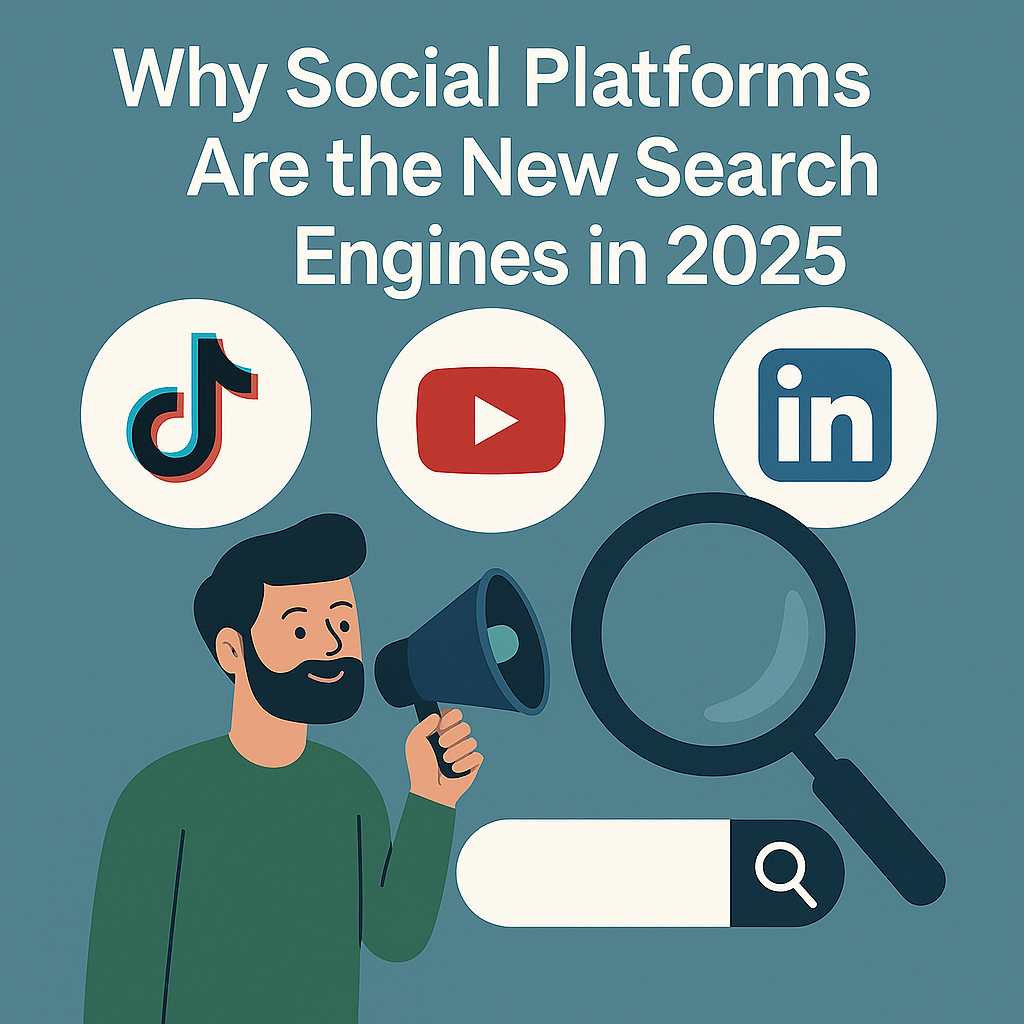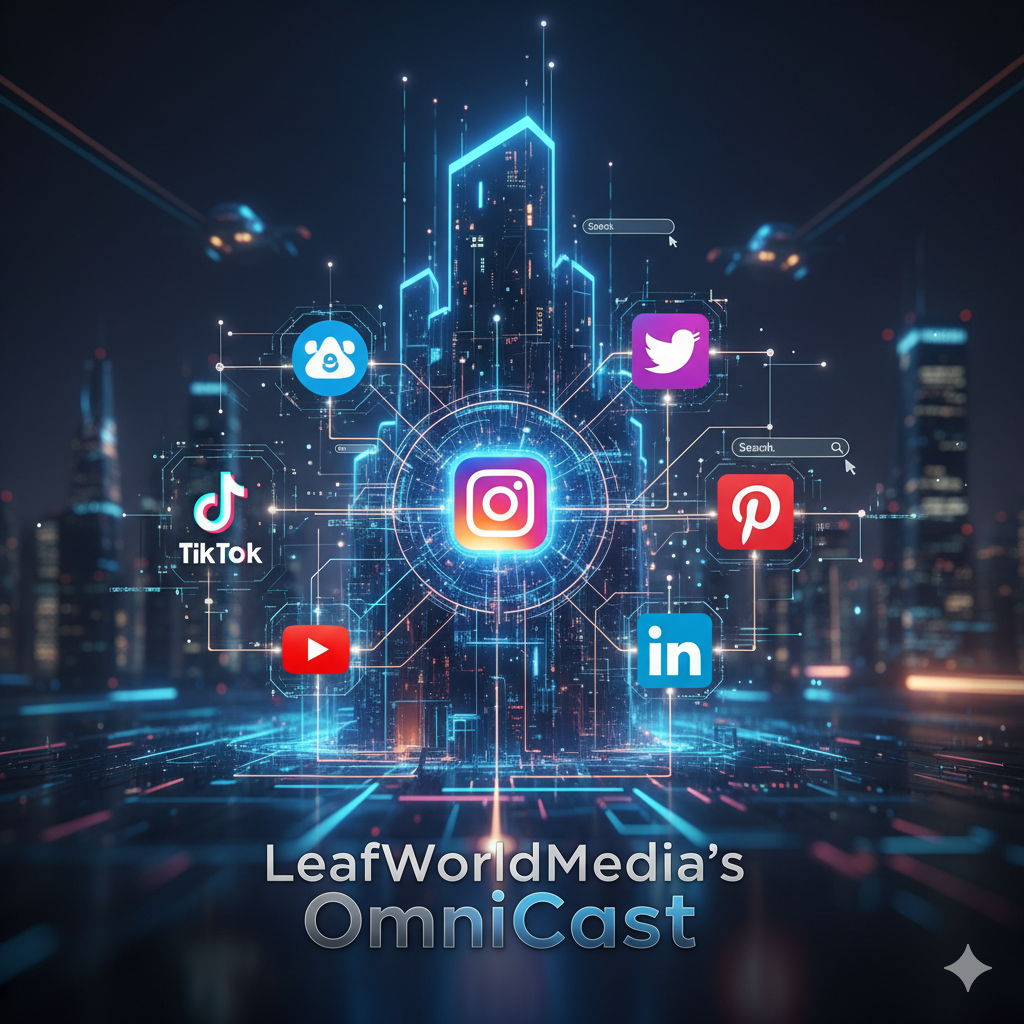Key Takeaways
- Social platforms are rapidly evolving into powerful search engines, with TikTok, Instagram, and YouTube now primary discovery tools for Gen Z and Millennials
- Brands face a multi-platform visibility crisis with content fragmentation across dozens of platforms, requiring new distribution strategies
- LeafWorldMedia’s OmniCast transforms single content pieces into platform-specific assets across 300+ Google News sites and social channels
- Multi-channel distribution has become more critical than content creation itself for maintaining brand visibility
- Businesses using omnichannel strategies like OmniCast see up to 140% increases in brand searches and significantly higher conversion rates
The search landscape has fundamentally transformed. Social media platforms are no longer just places to connect—they’ve become powerful engines of discovery where your audience searches for products, solutions, and information. This shift demands a complete rethinking of how brands distribute content to maintain visibility in 2025 and beyond.
Today’s digital consumers don’t just “Google it.” They scroll through TikTok for how-to advice, browse Instagram for product recommendations, and search YouTube for in-depth reviews. LeafWorldMedia’s innovative OmniCast platform helps brands navigate this fragmented attention landscape by ensuring content appears everywhere your audience is looking—not just where traditional SEO focused.
Social Platforms Are Now Search Engines: What This Means For Your Brand in 2025
The search revolution is already here. According to recent data, nearly 40% of Gen Z users turn to TikTok or Instagram instead of Google when looking for information. This behavior represents a fundamental shift in how people discover brands, products, and services. The implications for businesses are profound—if you’re not visible across multiple search environments, you’re increasingly invisible to potential customers.
This transition didn’t happen overnight. Social platforms have been strategically enhancing their search capabilities, recognizing that keeping users within their ecosystems drives engagement and advertising revenue. For brands, this means distributing content across a complex network of platforms has become essential, not optional—a challenge that LeafWorldMedia’s OmniCast was specifically designed to solve.
5 Ways Social Media Has Become the New Search Engine Landscape
The transformation of social platforms into search engines has occurred through multiple innovative features and user behavior shifts. Understanding these changes is crucial for any brand looking to maintain visibility in 2025’s fragmented discovery landscape.
TikTok’s Search Function Outperforms Google for Gen Z
TikTok has quietly become Gen Z’s preferred search engine. The platform’s intuitive search function delivers video results that many young users find more authentic and useful than traditional Google results. When searching for restaurants, products, or how-to advice, TikTok’s immersive video format provides immediate visual context that text-based search results cannot match.
Recent studies show that 60% of Gen Z users consult TikTok before making purchase decisions, with phrases like “TikTok made me buy it” becoming cultural shorthand for the platform’s influence. For brands, this means TikTok optimization is no longer just about viral content—it’s about searchable content that appears when users are actively seeking solutions.
Instagram’s Shopping Tags Create Product Discovery Pathways
Instagram has evolved from a photo-sharing app into a robust product discovery platform. The introduction of shopping tags, product catalogs, and in-app checkout has transformed how consumers find and purchase products. With over 1 billion monthly active users, Instagram’s search functionality now serves as a visual product search engine.
The platform’s Explore page algorithms have become increasingly sophisticated at matching users with products based on their interests and behaviors. This creates new imperatives for brands to ensure their products are properly tagged, categorized, and distributed across influential accounts—exactly the kind of cross-platform visibility OmniCast helps facilitate.
YouTube’s Position as the World’s Second-Largest Search Engine
YouTube has long held the position of the world’s second-largest search engine, processing over 3 billion searches monthly. What’s changed is how integrated YouTube results have become with other discovery systems. Google increasingly features YouTube content in featured snippets, while smart TVs and voice assistants prioritize video content in their search results.
The platform’s vast repository of how-to content, reviews, and demonstrations makes it the default destination for consumers seeking visual explanations. Brands that fail to maintain an active, searchable YouTube presence miss crucial touchpoints in the customer journey. This underscores the importance of transforming written content into video formats—a core capability of OmniCast’s content transformation process.
Search behavior on YouTube differs significantly from traditional search engines. Users typically input longer, more conversational queries and show greater patience with results, often watching multiple videos to find the information they need. This presents unique opportunities for brands to address specific pain points and questions through optimized video content.
Pinterest’s Visual Search Technology
“Pinterest isn’t just a social network—it’s a visual discovery engine with over 450 million monthly users conducting searches with commercial intent. The platform’s visual search technology allows users to find products and ideas based on images rather than keywords, creating a powerful discovery tool for retail and service brands.”
Pinterest’s Lens feature enables users to take photos of objects in the real world and find visually similar items on the platform. This technology bridges the physical and digital worlds in ways traditional search engines cannot. For home décor, fashion, and lifestyle brands, Pinterest has become an essential component of search visibility strategy.
LinkedIn’s Role in B2B Discovery
LinkedIn has transformed from a simple networking site into a comprehensive B2B search engine. Decision-makers increasingly use LinkedIn’s robust search features to find vendors, solutions, and industry expertise rather than turning to Google. The platform’s emphasis on professional credibility makes it a trusted source for business research.
With over 900 million professionals on the platform, LinkedIn has become the default discovery mechanism for B2B products and services. Its algorithm prioritizes authoritative content from established industry voices, making consistent publication and distribution on the platform essential for B2B visibility.
The platform’s advanced targeting capabilities allow content to reach specific decision-makers by industry, job title, company size, and more—creating powerful opportunities for precise audience targeting that traditional search engines cannot match.

The Multi-Platform Visibility Crisis Facing Brands Today
As social platforms evolve into search engines, brands face an unprecedented visibility challenge. The days of maintaining a single website with good SEO are long gone. Today’s digital landscape demands presence across dozens of platforms, each with unique content requirements and algorithms.
Content Fragmentation Across Dozens of Platforms
The proliferation of platforms has created a content fragmentation crisis. Brands must now maintain visibility across traditional search engines, social media, video platforms, podcasts, niche communities, and emerging spaces like AR/VR environments. Each platform requires specific content formats, dimensions, and engagement strategies to perform well.
This fragmentation strains resources as marketing teams struggle to create platform-specific assets at scale. Many brands find themselves prioritizing certain channels while neglecting others, creating visibility gaps that competitors can exploit. The solution lies in scalable content transformation and distribution—precisely the challenge LeafWorldMedia’s OmniCast was designed to address.
Algorithm Changes Affecting Organic Reach
Platform algorithms are increasingly designed to limit organic reach, pushing brands toward paid solutions. Facebook’s organic reach for business pages has declined to less than 5% of followers, while similar trends appear across Instagram, LinkedIn, and other major platforms. These algorithmic shifts create a moving target for brands trying to maintain visibility.
When platforms change their algorithms, brands without diversified distribution channels can see traffic and engagement plummet overnight. OmniCast’s multi-channel approach creates resilience against these changes by ensuring brand content exists across hundreds of touchpoints rather than relying on a handful of platforms.
Resource Limitations for Small to Mid-Sized Businesses
The expertise and resources required to maintain effective presence across multiple search environments have grown beyond what most small to mid-sized businesses can manage internally. Specialized knowledge of each platform’s unique optimization requirements, combined with the content production demands, creates an almost impossible challenge for limited marketing teams. For those looking to streamline their efforts, LeafWorldMedia’s OmniCast offers a solution to maximize brand visibility across social platforms.
Even larger enterprises struggle to coordinate cohesive multi-platform strategies across siloed departments. This resource gap has created demand for unified solutions like OmniCast that can transform and distribute content at scale without requiring massive team expansion.

LeafWorldMedia’s OmniCast: Your Omnichannel Solution
In response to the multi-platform visibility crisis, LeafWorldMedia developed OmniCast—a comprehensive content distribution platform designed to transform single content pieces into dozens of platform-optimized assets and distribute them across a vast network of channels. This approach ensures brands maintain visibility wherever their audience is searching.
What Makes OmniCast Different from Traditional Distribution Tools
| Traditional Distribution | OmniCast Approach |
|---|---|
| Single-format distribution | Multi-format transformation and distribution |
| Limited channel reach | 300+ Google News sites plus social platforms |
| Manual optimization for each platform | AI-powered automated optimization |
| Separate tools for different platforms | Unified dashboard and analytics |
Traditional content distribution tools typically push identical content to multiple channels without format adaptation, resulting in poor engagement and search visibility. OmniCast fundamentally reimagines this approach by transforming content to match each platform’s unique requirements before distribution.
While competitors focus primarily on press release distribution or social scheduling, OmniCast provides end-to-end content transformation, optimization, and placement across a vastly larger network of properties. This comprehensive approach ensures content appears in multiple search environments simultaneously.
The platform’s AI-driven optimization ensures content meets platform-specific best practices without requiring specialized knowledge from the brand team. From character counts to hashtag optimization to metadata formatting, OmniCast handles technical details automatically.
Perhaps most importantly, OmniCast creates content distribution resilience. When one platform changes its algorithm or reduces organic reach, your brand maintains visibility across hundreds of other touchpoints, creating stability in an increasingly volatile digital landscape.
The Technology Behind Cross-Platform Content Transformation
At the core of OmniCast’s capabilities is its advanced content transformation engine. Using a combination of AI technologies and specialized media production teams, the platform can transform a single piece of content into dozens of platform-optimized variations. This includes converting written content to video, audio to social snippets, long-form articles to infographics, and much more.
The transformation process preserves the core message and brand voice while adapting format, length, style, and presentation to match each platform’s unique requirements. This ensures content performs well in each environment while maintaining consistent messaging across all channels—a critical component of effective brand building in 2025’s fragmented attention landscape.
Distribution Network: 300+ Google News Sites and Beyond
OmniCast’s distribution network extends far beyond traditional content syndication services. The platform maintains relationships with over 300 Google News-approved websites spanning diverse industries and interests. This network ensures brand content appears in trusted news sources that receive preferential treatment in search results, featured snippets, and news carousels, creating powerful SEO benefits alongside direct visibility. Learn more about OmniCast’s capabilities in enhancing brand visibility.
How OmniCast Transforms Single Content Pieces into Multi-Platform Assets
The true power of OmniCast lies in its ability to take a single content piece and transform it into dozens of platform-specific assets. This transformation process is structured around five key capabilities that work together to maximize content visibility across the digital landscape.
1. Content Adaptation for Platform-Specific Requirements
Each social platform has unique content specifications that influence algorithm performance and user engagement. OmniCast’s content adaptation engine automatically reformats content to match these requirements. For Twitter/X, content is condensed into concise, high-impact statements with appropriate hashtags. On LinkedIn, the same content is expanded with professional framing and industry-specific terminology. For Instagram, visual elements are prioritized with careful attention to aspect ratios and aesthetic consistency.
This platform-specific adaptation extends to technical specifications as well. Image dimensions, video length, character counts, and metadata are all automatically optimized for each destination. The result is content that appears native to each platform rather than awkwardly repurposed, significantly improving engagement metrics and search visibility.
2. Format Conversion (Text to Video, Audio, Graphics)
OmniCast’s format conversion capabilities transform written content into multiple media types to match how users consume information on different platforms. A single blog post can become a YouTube video, podcast episode, infographic for Pinterest, carousel post for Instagram, and short-form video for TikTok—all while maintaining consistent messaging and branding.
This cross-format transformation is particularly valuable for reaching different audience segments who prefer consuming content in specific ways. Some users prefer reading, others watching, and still others listening. By converting content across formats, brands can reach their entire audience regardless of content consumption preferences.
The platform uses advanced AI tools to extract key points from longer content, identify visual storytelling opportunities, and develop compelling narratives for different media formats. Human oversight ensures brand voice consistency and quality control throughout the transformation process.
3. SEO Optimization Across Multiple Search Environments
Each platform has its own search algorithm with unique ranking factors. OmniCast applies platform-specific SEO optimization to ensure content performs well in each search environment. For YouTube, this includes transcript optimization, strategic timestamp placement, and thumbnail selection. On Pinterest, it involves keyword-rich descriptions and category alignment. For TikTok, trending sound integration and hashtag optimization.
The platform maintains a constantly updated database of platform-specific ranking factors based on actual performance data rather than speculation. This data-driven approach ensures optimization strategies remain effective even as algorithms evolve. The result is content that consistently ranks well across multiple search environments, creating maximum discovery opportunities.
4. Automated Publishing and Scheduling
OmniCast’s publishing engine handles the complex logistics of distributing content across hundreds of platforms and properties. The system determines optimal posting times for each platform based on audience activity patterns and content type. It manages publishing queues to prevent content overlap and ensures steady visibility throughout the week. Learn more about OmniCast and its capabilities.
This automated scheduling extends to content sequencing strategies. For complex topics, OmniCast can break content into logical segments released in sequence to build audience engagement over time. The platform also incorporates cross-platform promotion, using each channel to drive traffic to others in a coordinated distribution strategy.
5. Performance Analytics and Optimization
Once content is distributed, OmniC
E-commerce Brand Boosts Conversion Rates with Omnichannel Presence
Fashion retailer Moonlight Styles was struggling with rising customer acquisition costs and declining conversion rates despite creating high-quality content. After implementing OmniCast, their content began appearing across fashion blogs, Google News sites, shopping platforms, and social channels simultaneously. The visibility transformation was dramatic and immediate.
Within three months, Moonlight Styles saw a 67% increase in organic traffic and a 43% boost in conversion rates. Their customer acquisition costs dropped by nearly 30% as multi-channel visibility created powerful reinforcement effects. Potential customers now encountered the brand across multiple touchpoints before making purchasing decisions, significantly increasing trust and purchase intent. As the CMO noted, “We’re no longer just hoping customers find us—we’re everywhere they’re already looking.”
The Future-Proof Strategy: Why Multi-Channel Distribution Matters More Than Content Creation
 ,,,,,,,,,,,,,, We’ve entered a paradigm shift in digital marketing where distribution strategy has become more critical than content creation itself. Even exceptional content delivers minimal ROI if it fails to reach audiences across the fragmented platforms where they spend time. The most successful brands in 2025 are those prioritizing omnichannel distribution as their core strategy.
,,,,,,,,,,,,,, We’ve entered a paradigm shift in digital marketing where distribution strategy has become more critical than content creation itself. Even exceptional content delivers minimal ROI if it fails to reach audiences across the fragmented platforms where they spend time. The most successful brands in 2025 are those prioritizing omnichannel distribution as their core strategy.
This shift requires rethinking traditional marketing budgets. While many brands still allocate 80% of resources to content creation and 20% to distribution, top-performing companies are inverting this ratio. By focusing on distribution-first strategies, these brands achieve significantly higher returns on their content investments and build resilience against platform volatility. LeafWorldMedia’s OmniCast platform was specifically designed to support this distribution-centric approach without requiring massive team expansion.
The End of the “If You Build It, They Will Come” Era
The content marketing myth that quality content naturally attracts audience attention has been thoroughly debunked. Today’s digital landscape is saturated with excellent content competing for limited attention. Without strategic, multi-channel distribution, even the most valuable content remains effectively invisible. Success now depends on engineered discoverability across multiple search environments rather than passive hope for organic discovery.
Distribution-First Content Strategy
Leading brands have shifted to a distribution-first mindset where content is conceived with specific distribution channels in mind from the beginning. Rather than creating content and then figuring out where to share it, these brands start by identifying platform-specific opportunities and then develop content tailored to each environment’s unique requirements. For example, LeafWorldMedia’s OmniCast helps brands maximize their reach by optimizing content for various social platforms.
OmniCast facilitates this approach by providing insights into trending topics across platforms and identifying distribution opportunities before content creation begins. This strategy ensures every piece of content has maximum potential for visibility and engagement across the entire digital ecosystem, rather than performing well on a single platform while underperforming elsewhere.
Measuring Cross-Platform ROI
As visibility fragments across platforms, traditional single-channel attribution models have become increasingly ineffective. Advanced brands now measure campaign success through unified cross-platform analytics that track audience journeys across multiple touchpoints. OmniCast’s integrated analytics dashboard provides this comprehensive view, allowing marketers to understand how content performance on one platform influences results on others and make data-driven optimization decisions.
Take Action Now: Secure Your Brand’s Visibility in the New Search Landscape
The transformation of social platforms into search engines isn’t coming—it’s already here. Brands that adapt quickly gain significant competitive advantages while those clinging to outdated single-channel strategies face increasing invisibility. LeafWorldMedia’s OmniCast platform offers a comprehensive solution to the multi-platform visibility challenge, enabling brands of all sizes to maintain presence across the entire digital ecosystem without overwhelming internal resources.
Frequently Asked Questions
As brands explore multi-channel distribution strategies, several common questions arise about implementation, effectiveness, and optimization. Here are answers to the most frequently asked questions about OmniCast and omnichannel visibility.
How does OmniCast compare to hiring multiple agency specialists?
OmniCast provides an integrated solution that eliminates the coordination challenges and inconsistencies that typically arise when working with multiple specialized agencies. While hiring separate specialists for each platform offers expertise, it often creates siloed strategies, messaging inconsistencies, and significant management overhead.
From a cost perspective, OmniCast typically delivers 60-70% savings compared to the combined expense of platform specialists while providing more comprehensive coverage. The platform’s unified analytics also offer clearer performance insights than attempting to aggregate reporting from multiple agencies with different measurement methodologies.
Perhaps most importantly, OmniCast’s integrated approach ensures brand messaging remains consistent across all channels while still adapting to platform-specific requirements. This consistency is difficult to maintain when working with multiple agencies, each with their own creative interpretation of brand guidelines.
What types of content work best with OmniCast’s distribution system?
While OmniCast can distribute any content type, the system delivers particularly strong results for thought leadership content, industry insights, product launches, customer success stories, and educational materials. Content with clear audience value propositions and actionable information typically generates the highest engagement across platforms, regardless of industry or sector.
How quickly can I expect to see results after implementing OmniCast?
Most brands begin seeing significant visibility improvements within the first 30 days as content appears across hundreds of previously untapped channels. However, the compounding effects of omnichannel distribution typically accelerate over time, with the most dramatic performance improvements often occurring between months three and six.
The timeline varies somewhat by industry, with B2C brands often seeing faster traffic and engagement results, while B2B companies experience more gradual growth in pipeline velocity and lead quality metrics. OmniCast’s analytics dashboard provides real-time visibility into performance trends across all platforms, allowing for continuous optimization throughout the visibility-building process.
Does my business need to create new content for OmniCast to work effectively?
OmniCast can transform and distribute both existing and new content. Many brands begin by repurposing their highest-performing existing assets to quickly expand visibility across new channels. The platform’s content transformation capabilities can refresh and adapt older content to make it relevant for current distribution, extracting additional value from previous content investments.
For ongoing campaigns, many clients adopt a hybrid approach—creating core content pieces that OmniCast then transforms into dozens of platform-specific variations. This strategy maximizes efficiency while ensuring continuous visibility across the entire digital ecosystem. The platform’s content strategists can provide guidance on which existing assets offer the strongest transformation potential for specific campaign objectives. Learn more about OmniCast here.
How does OmniCast help with Google’s AI Overview feature taking traffic from source sites?
Google’s AI Overview feature presents a significant challenge for many content publishers as it extracts and presents information directly in search results, potentially reducing clicks to source websites. OmniCast addresses this challenge through two key strategies that help brands maintain visibility and traffic despite these AI extractions.
First, OmniCast distributes content across multiple Google News-approved sites, significantly increasing the likelihood that your brand’s content will be selected as a source for AI Overviews. When Google’s AI summarizes information, it prioritizes content from authoritative sources—precisely the type of sites in OmniCast’s distribution network. This approach turns AI Overviews from a threat into an opportunity for increased brand visibility.
- Distribution across 300+ Google News sites increases source citation opportunities
- Multi-format content creation ensures visibility beyond text-based search results
- Strategic structured data implementation improves rich result opportunities
- Platform diversification reduces dependence on Google traffic
- Authority building through consistent publishing improves AI source selection
Second, OmniCast’s multi-platform approach reduces dependence on Google search traffic altogether. By establishing visibility across social platforms, video channels, podcast directories, and other discovery environments, brands build multiple traffic sources that aren’t affected by Google’s AI Overview extractions. This distribution diversity creates resilience against algorithm changes and feature implementations across any single platform.
The platform also employs advanced structured data strategies that increase opportunities for rich results and featured snippets, ensuring your content maintains visual prominence even as traditional organic listings evolve. This technical optimization happens automatically as part of the distribution process, requiring no additional effort from brand teams.
In the rapidly evolving digital landscape, businesses are constantly seeking ways to enhance their online presence and engage with their target audience effectively. One strategy that has gained significant traction is the use of OmniCast, a comprehensive approach to maximizing brand visibility across multiple platforms. By leveraging this innovative method, companies can ensure that their content reaches the right audience at the right time, ultimately driving increased engagement and conversions.







Leave a Reply